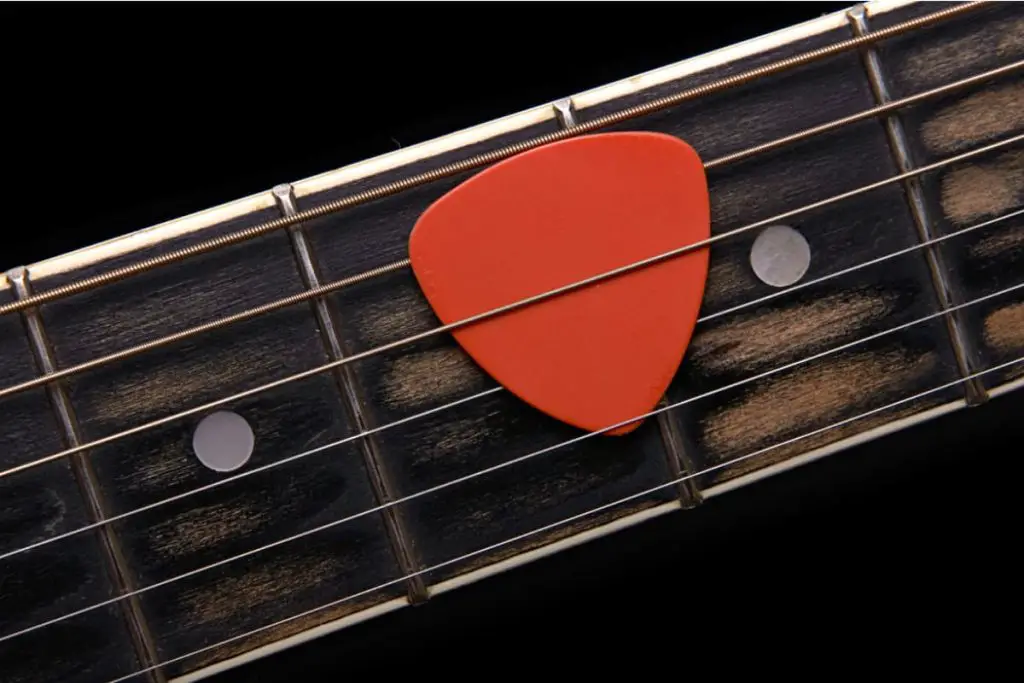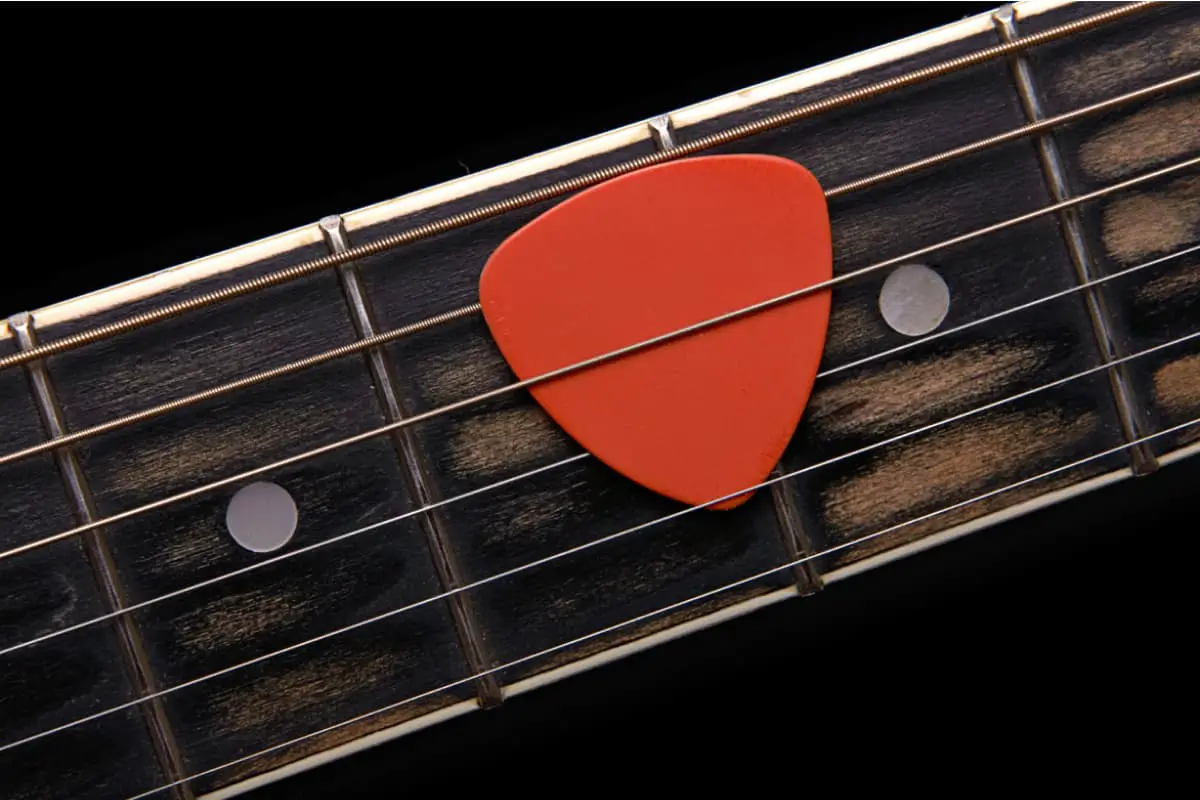Learning to play guitar might start with finger positions and basic chord memorization, but choosing the right pick is also a crucial part of the process. However, understanding why your guitar pick sounds terrible isn’t something that’s covered in most beginner-level guitar courses.
Here are 5 reasons why your guitar pick sounds bad:
- You’re holding the pick at an awkward angle.
- It’s time to practice your pick technique.
- You’re squeezing the guitar pick too tightly.
- You’re not using the correct type of pick.
- The guitar is out of tune.
Let’s explore these reasons in greater detail to ensure that every strum with your guitar pick produces the sound you’re listening for.
👇😀👇NOTE👇😀👇
If you want to find out what my recommended guitar gear is, then here is what I recommend on Amazon:
- Fender Cutaway Acoustic-Electric Guitar Bundle (MY FAVORITE GUITAR)
- Snark SN-8 Super Tight All Instrument Tuner (Easiest Tuner I’ve Used😏)
- 6 String Acoustic Guitar Capo (Best CAPO for quick changes)
- Dunlop Max Grip 1.0mm Nylon Picks (Thick Guitar Pick So You Don’t Lose Grip!)
- Universal Guitar Stand (Cheap & Minimalist Guitar Stand I Recommend)
- Levy’s 2″ Wide Quick Adjust Guitar Strap (Best Guitar Strap For Any Level)

1. You’re Holding the Pick at an Awkward Angle
Holding your guitar pick at an awkward angle (either completely flat or at a steep slope) while picking or strumming can produce unwanted twangs and buzzes. This issue is common, especially among players learning to use a pick.
Fortunately, adjusting your hand position and pick angle can resolve this problem, helping your guitar pick sound far better than before. Still, if you’re new to using a guitar pick, learning to hold it while strumming or picking can take practice.
How To Hold Your Guitar Pick Correctly
Many beginner-level (and intermediate) guitar players hold their pick at a sharp up-and-down angle or entirely horizontal with the strings. The reason behind these positions is the belief that they can offer more leverage when striking a string.
Your pick should be almost horizontal while playing, with the broader end tilted slightly downward and the tapered end pointed ever so slightly upward. Pushing downward on the pick with your thumb is an excellent way to achieve a proper angle, but you may need to practice this hold to get it just right.
Unsure where to start? You might want to check out a video walkthrough to help you achieve the ideal pick angle. Here’s a top-notch instructional guide to get you started:
Remember, even the best picks can produce awful sounds if you’re not holding them correctly or practicing your picking technique. With this in mind, you’ll want to consider studying proper pick-holding methods and picking techniques if your guitar pick sounds bad.
2. It’s Time To Practice Your Pick Technique
Naturally, guitar picks don’t emit sounds like a guitar does. So, when your playing doesn’t sound quite right while using a pick, the culprit could be your picking technique.
While this isn’t accurate 100% of the time, practicing your technique could correct any unwanted sounds emanating from your guitar while you’re playing with a pick. Fortunately, there are tons of online courses that can help you improve the way you handle and use your guitar pick.

Pick Technique Courses To Improve Your Skills
If you’re actively taking in-person guitar lessons, you can ask your instructor to teach you proper pick handling and pick techniques. But if you’re learning independently from home, an online video-based course is the best course of action.
Now, you have quite a few options when it comes to practicing your technique.
For example, if you’d like to start immediately, you can watch free video guides on YouTube. One of the better free-to-watch instructional videos available on this platform is from
YGSGuitarLessons:
Still, some students may benefit from a more in-depth guide to picking techniques. If this applies to you, consider enrolling in an online course that includes exercises.
An excellent option is The 3 Key Elements of Perfect Guitar Picking, a Udemy course that can introduce you to pick types, proper pick holding, and the difference between attacks and accents. This class also includes playing exercises, allowing you to master your technique.
After studying and practicing, you may find that your guitar picking sounds significantly better, making each play session far more enjoyable.
Of course, technique can only take you so far. If you’re clenching up on the pick each time you sit down to play, your guitar pick might continue to sound less-than-stellar.
3. You’re Squeezing the Guitar Pick Too Tightly
Let’s say that you’re holding your pick at the correct angle and practicing your pick technique, but your guitar pick still produces unpleasant noises. In this case, you might simply be squeezing your pick too tightly!
While you’ll want to have a firm hold on your pick while strumming or picking individual strings, clamping your fingers onto the pick too tightly can cause the muscles and tendons in your wrist to tighten, making your movements less fluid.
A quick physical check-in is often the best way to resolve this problem.
How To Release Finger Tension Before Using a Guitar Pick
After getting into playing position, take your pick and poise it at the strings—but don’t strike yet.
While holding the pick, take a moment to notice how your wrist and arm feel. If they feel tense and tight, take a deep breath and let the muscles relax, allowing some of the pressure between your thumb and pointer finger to dissipate.
Rotate your wrist slowly to help release any remaining tension, then begin playing. You may be surprised to find that a bit of relaxation helps your guitar pick sound just as it should.
Of course, if you’re not using the correct type of pick, no amount of proper angling, technique, or finger pressure will make your guitar pick sound better.
4. You’re Not Using the Correct Type of Pick
There are hundreds of types of guitar picks, and each is suited to a specific type of guitar, string set, and playing style.
So, if you’ve grabbed a standard nylon pick from your local music store, it might sound bad because it’s not the right choice for your instrument. To fix this issue, you’ll want to familiarize yourself with the type of guitar picks and choose the correct type for your guitar.

Types of Guitar Picks
Guitar picks are categorized based on a few key qualities:
- Shape
- Thickness
- Material
Selecting the best ones for your guitar comes down to understanding these qualities and how they affect your playing.
Guitar Pick Shape
Though a standard triangular guitar pick might be easily recognizable, it’s far from the only pick shape. In total, there are eight common guitar pick shapes, including:
- Standard (also called a 351)
- Standard Sharp Tip
- Jazz
- Pointy
- Triangle
- Shark Fin
- Teardrop Thin
- Teardrop Wide
Picks with a rounded tip (like the Standard 351) are often best for beginners and acoustic guitars, as they strike a guitar’s strings more gently than pointed picks. These picks also glide across multiple strings easily, making them ideal for playing chords on acoustic instruments.
Suppose you’re playing an electric guitar (or mastering multi-note attacks). In that case, a sharper, pointed guitar pick is often the better choice because it allows for more direct contact with individual strings.
After selecting the best shape for your guitar and playing style (strumming versus picking), you’ll need to choose a pick with the right thickness for your strings.
Guitar Pick Thickness
A common misconception beginner-level players have is that there’s only one pick thickness. However, guitar picks are available in a wide variety of thickness levels, varying from Extra Thin (less than 0.40mm thick) to Extra Heavy (at least 1.50mm thick).
Thin guitar picks are lighter, making them an ideal choice for beginners and acoustic players. These picks also strike with less force than thicker options, so they’re an excellent option for those who prefer playing chords and strumming.
If you’re playing a guitar with thicker strings, you’ll want to choose a thick pick that accentuates your instrument’s deeper, lower notes. A medium-thickness pick is often well-suited to electric guitars.
Still, it’s crucial to experiment with different pick thickness levels to find one that suits your instrument and play style.
Guitar Pick Material
A guitar made of wood sounds very different from one made of steel or thick plastic. Guitar picks are similar in this sense, as their material significantly affects the sounds they produce.
Guitar picks are often made of a variety of materials, including:
- Acetate
- Acrylic
- Carbon Fiber
- Nylon
Nylon guitar picks are the most common, and they’re often more flexible than pricier carbon fiber options. Nylon guitar picks are excellent for acoustic strumming, but they are prone to cracking and breaking more quickly than other picks.
Acetate picks are almost as flexible as nylon picks, but they’re often more durable. Still, those with electric guitars may want to choose an acrylic pick, as acrylic tends to be stiffer than both nylon and acetate. This quality makes them better for single-string attacks.
Carbon fiber guitar picks are best-suited to bass guitars, as they’re inflexible and highly durable, helping them withstand the rough exterior of bass guitar strings.
Signs of a Worn Guitar Pick
Even the highest-quality guitar picks wear down over time. So, if you’re confident that you’re using the right pick for your guitar, but the pick is still negatively impacting your instrument’s sound quality, it might be time to replace it.
Remember, even the most durable guitar picks can wear down and break over time. After all, a guitar pick’s primary purpose is to strike strings, so a pick constantly takes on impact damage.
If you’re playing an electric or bass guitar, these impacts can be more intense due to the thicker strings on these instruments. Keeping an eye out for signs of wear and tear is a fantastic way to ensure your guitar pick sounds excellent.
The most common signs of a worn guitar pick include:
- Frayed pick edges
- Delamination of pick surface
- Chips along the pick edges
- Cracks in the pick body
- An inability to lie flat on a surface
If your current pick exhibits any of these signs, it’s time to replace it. Doing so can immediately improve the sound quality of your guitar playing.
Still, sometimes your pick isn’t to blame for your guitar’s out-of-tune notes and unpleasant sounds.
5. The Guitar Is Out of Tune
Sometimes, the unwanted tones coming from your guitar aren’t due to a faulty pick. If you’re playing with a brand-new guitar or you haven’t tuned your guitar in a while, it may simply be out of tune.
So, if your guitar pick sounds terrible, one of the first things you’ll want to do is check the guitar’s tuning.

How To Check Your Guitar’s Tuning
For most guitars, the standard tuning is E-A-D-G-B-E. The first string (the one facing upward while holding the guitar in a playing position) is the lowest note, and the last (the closest to your knees while holding the guitar) is the highest-pitched note.
Unless you’ve got an excellent ear for specific pitches, you’ll likely want to use a guitar tuner to check that your instrument is correctly tuned. There are a couple of types of tuners from which to choose.
For example, you can purchase a handheld tuner or use a guitar tuning app. The right option for you depends on your budget and preferences.
Choosing a Handheld Guitar Tuner
To use a handheld guitar tuner, you’ll need to turn it on (typically by depressing the power button), pluck each guitar string individually, and read the note that registers on the tuner. Nearly all handheld guitar tuners work this way.
While this shared functionality can be a blessing, it can also make it challenging to choose the best possible tuner.
Still, many of the best handheld guitar tuners for beginners are simplified clip-on devices with bright, easy-to-read screens. The SNARK SN5X Clip-On Tuner (available on Amazon.com) is an excellent example.
This device clips onto the top of the headstock, allowing you to check your guitar’s tuning without bending down after each pluck to read the device’s screen. Its screen displays large letters corresponding with each note, so you’ll never need to squint to read it.
Additionally, the SNARK Clip-On Tuner displays precise pitch using color-coded bars, allowing you to perfect the pitch of each string precisely. The rotating display head makes it easy to tune from virtually any position, so you can tune while holding your guitar in the playing position.
This device also has a metronome function, making it an ideal multipurpose device for tuning and mastering songs at different tempos. But if you’d prefer, you can invest in a guitar tuning app for your smartphone or tablet instead of buying a handheld tuner.
Using a Guitar Tuning App
You can install a tuning app on your preferred internet-connected device if you’d rather minimize your guitar gear. There are dozens of guitar tuning apps available on Android and iOS devices, but some are pricier (and more complicated) than others.
Beginner-level players may want to keep things simple by choosing a low-cost app with fewer setting options. Fender Guitar Tuner is one of the best options, as it displays notes in large letters on your device screen.
The basic version is free to download and use, making it an ideal choice for those with a tight budget. In addition, Fender Guitar Tuner is compatible with iOS and Android devices, so you can use it on virtually any device.
To use this app, you’ll need to download it, open it, and select the Auto Tuner function. After that, allow the app to access your device’s microphone, then begin tuning! The app will tell you whether to tune each string to a lower or higher note based on the standard tuning scale.
How To Tune Your Guitar
After you’ve selected a tuner type, you can check each string’s tuning. If you find a string that’s out of tune, correcting it is a straightforward process that should only take a few seconds.

To tune your guitar, you’ll want to follow these steps:
- Turn on your chosen tuning device and set it to the standard tuning.
- Pluck the topmost string (low E) and see if the note registers correctly.
- Adjust the tuning keys as necessary.
- Pluck the top string again until it registers as an E.
- Continue this process for each string until you’ve achieved standard tuning.
If you’re a visual or auditory learner, you might want to watch a helpful guide that explains the tuning process in more detail. This practical video guide can help:
Factors Affecting Your Guitar’s Tuning
Keeping your guitar in tune is one of the best ways to ensure that your pick sounds solid while you’re playing. There are several factors affecting your guitar’s tuning, including:
- Humidity
- String condition
- String tightness
- Faulty tuning keys
Keeping your guitar in a cool, dry environment and maintaining its components (particularly its strings and tuning keys) are fantastic ways to keep it from falling out of tune often. That said, you may need to adjust your guitar’s tuning before each play session.
After all, the force created by strumming and picking can cause the tuning keys to twist slightly, resulting in a changing string pitch over time.
If your guitar pick sounds bad even after tuning, you might be working with old, worn-out strings. In this case, changing your strings might be the best way to achieve a more precise and desirable sound.
👇😀👇NOTE👇😀👇
If you want to find out what my recommended guitar gear is, then here is what I recommend on Amazon:
- Fender Cutaway Acoustic-Electric Guitar Bundle (MY FAVORITE GUITAR)
- Snark SN-8 Super Tight All Instrument Tuner (Easiest Tuner I’ve Used😏)
- 6 String Acoustic Guitar Capo (Best CAPO for quick changes)
- Dunlop Max Grip 1.0mm Nylon Picks (Thick Guitar Pick So You Don’t Lose Grip!)
- Universal Guitar Stand (Cheap & Minimalist Guitar Stand I Recommend)
- Levy’s 2″ Wide Quick Adjust Guitar Strap (Best Guitar Strap For Any Level)
Related Posts:

